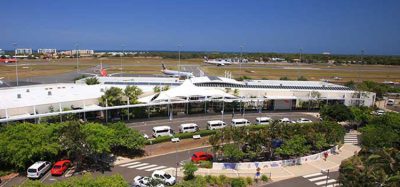Aviation must always be prepared for the unknown, says CEO of Ontario Airport Authority
Posted: 31 August 2020 | International Airport Review | No comments yet
In the latest instalment of our exclusive CEO series, Mark Thorpe, CEO of Ontario International Airport Authority, discusses the importance of shifting the industry’s mindset to a business point of view and the need to consider the consumer.


How did your career in the aviation industry begin?
I’ve always been interested in airlines, airports and air travel, but I didn’t grow up thinking “oh, that’s what I want to do”. During my final year of a JD/MBA programme at George Washington University years ago, the opportunity presented itself to work as a graduate research assistant in an airline management programme. I took that opportunity, and I wound up really liking it.
I was struck right away by how challenging the aviation industry is. It’s so dynamic, with such complex choreography. There are planes in the air 24 hours a day, over oceans and over continents. Airports, for me, are the crossroads of the world – where people from different countries, speaking different languages, come together. They’re really interesting places for culture and commerce. You can also get pretty much any kind of job you want at an airport; they’re like their own cities.
What is the most rewarding aspect of being an airport authority CEO? On the other hand, what is most difficult?
These are very interesting times and, as CEO, I love that I have the opportunity to develop and execute our vision and decide how we adapt that vision during challenging times, like the present. The other rewarding part of this job is being responsible for everyone in the organisation – I take that very seriously. Every day, there is an opportunity to mould and shape someone’s career – to invest time and belief in someone who maybe doesn’t see it in themself, or doesn’t know how to chart the right course to accomplish all that they can during their career.
This human part of the job can also be the most difficult, especially in times like these, where you may have to make difficult personnel decisions.
At the end of the day, we’re going to achieve what we’re going to achieve because we’ve got a strong vision, a solid strategy and great people working together. The ultimate reward for me is sharing in our achievements as a team, but also seeing individuals grow and develop as we do so.
Can you give us an overview of the three most exciting developments currently happening at Ontario International Airport?
We’ve built something incredible here and, even in the midst of a global pandemic, Ontario International Airport (ONT) is better positioned for the future than I think this airport ever has been.
Even in the midst of a global pandemic, Ontario International Airport (ONT) is better positioned for the future than I think this airport ever has been”
Firstly, we’re Southern California’s newest and fastest-growing aviation gateway. Before COVID-19, we were experiencing consistent double-digit year-over-year growth in passenger traffic. The addition of China Airlines flights to Taiwan made us the only airport in Southern California, other than Los Angeles International Airport (LAX), to offer a trans-pacific service. We’ve also brought in non-stop services to Mexico City, New York, Atlanta, Orlando, Houston and other destinations.
Secondly, our airport’s role as one of the world’s most important e-commerce and supply chain hubs has only grown during the pandemic and, through July 2020, freight traffic at Ontario Airport was up by 21 per cent from 2019 levels. During November 2020, FedEx will dedicate its new 51-acre regional hub campus, with facilities and ramp space that will allow it to grow dramatically. With UPS and Amazon, we’re one of few airports anywhere that can claim three freight hubs.
Finally, we’re a key economic driver for one of the fastest-growing population and economic centres in the U.S., contributing billions of dollars a year to our local economy.
What is the biggest challenge Ontario International Airport is having to tackle?
Certainly, the impact of COVID-19 is something we’ll be dealing with for a long time. However, we’re confident air travel will return. Our airline partners feel the same way and have been scheduling the return of air service to the airport on a consistent basis during summer 2020. At the same time, we recognise that passengers’ expectations are very different now, particularly where health and safety are concerned.
As an airport, and as an industry, we not only have to make our facilities safer than they’ve ever been, but we also need to convince our customers that it’s okay to fly. That’s going to require a concerted, collaborative effort on the part of the airport, our airlines and other business partners, and even those in the community who shape public opinion.
It won’t be an easy task, but it’s something we’re laying the groundwork for and will invest heavily in.
At this moment in time, what do you see as the biggest disruptor to the aviation industry?
The biggest disrupter is not a ‘what’, but a ‘who’ – the consumer”
It’s not a ‘what’, but a ‘who’ – the consumer. People today have so much more knowledge and so much more control over their spending choices. In the airline industry, that shift started years ago, with the advent of the internet and third-party travel sites that disrupted the traditional global distribution system. Although travellers have had the ability to make their own travel arrangements for some time now, I think that we will see their power to make their own choices, and the range of decisions that they will make, grow significantly and, in so doing, dramatically re-shape the way that airlines and airports do business if they want to thrive.
Take millennials, for instance. They care a lot less about all of the traditional benefits of airline loyalty programmes (such as frequent flier miles, upgrades, airport lounge access), especially if those benefits require loyalty that impedes the flexibility or values that are important to them. If airlines, and even airports, are not aware of our need to be flexible and unbundle and tailor benefits to fit a wide array of preferences and values, we will lose out to more innovative and proactive competitors.
On the other hand, those among us that embrace this shift of power – and, most importantly, take the time to ask their customers what they really care about and how they want us to engage with them – are going to be in a much better place. Technology will allow us to be very specific in how we tailor what we offer, but the determinative factor for success will be how much we invest in asking, listening, researching and understanding what the market needs and wants, rather than thinking that we can anticipate those needs and wants.
We need to do a better job of not being at the centre of where so much of it all happens, but ensuring that it all happens in an increasingly efficient and successful way”
On the airport side specifically, we need to get away from our old bureaucratic way of thinking and operate as businesses, focusing on extracting maximum value from those airline and business partnerships that are most mutually beneficial, and moving away from being places where airlines operate to centres of economic activity and commercial development and growth. To succeed, I believe that we need to do a better job of not being at the centre of where so much of it all happens, but ensuring that it all happens in an increasingly efficient and successful way, year after year.
In your opinion, how does the aviation industry need to adapt to secure its place in the future?
It starts by changing our way of thinking. It’s not just about the cheapest flight anymore, but the customer experience. For airports, convenience matters, and so do the services and amenities you offer.
Here in Southern California, with a growing population and too much traffic already, accessibility will be a bigger factor moving forward, which is why we’re happy with some of the innovative transit proposals being developed into and out of Ontario Airport.
We need to stop thinking of ourselves as airports, and start thinking as businesses”
Cost of operations are another area we’re going to need to focus on – in our case, by finding new and effective ways to grow non-aviation revenues. We can’t keep billing airlines for everything. If they’re having to pay significantly higher landing fees at one airport versus another, at some point they’ll pull back doing business there.
We need to stop thinking of ourselves as airports, and start thinking as businesses.
What does the future of the aviation industry look like to you?
I think we’ve got a great future. Yes, we’re being impacted by a global pandemic and, if history teaches us anything, it’s that every seven to 10 years something drastic will happen in the global aviation industry. We need to be prepared for the unknown – but almost guaranteed to happen – events or crises. We need to be prepared not just to survive, but to innovate, adapt comparatively fast, take advantage of opportunities and thrive. We always need to avoid permitting these downturns to limit our vision.
Our economy is a global one, and so is our industry. We need to always raise our horizon line and believe that, just because it is not the way that things have been at our airport, or in our industry, that they can’t be re-shaped by great ideas and solid, creative new approaches. Ontario Airport is a gateway to the second-largest market in the U.S., and one of the most important centres of economic activity in the world, and we always have to act like it, even if it will take airlines and other partners awhile longer to come around to joining us.
The surge in e-commerce in and around Ontario Airport also provides a tremendous opportunity for our airport. Since the pandemic, freight traffic as Ontario Airport is up by more than 20 per cent year over year, and our freight partners believe that’s only the beginning. So, we need to leverage that type of activity with all of the opportunities for our region to grow, such as international trade, robotics, smart warehouse and distribution centre technology, and supply chain and logistics management, to name a few among many.
Listening to our customers, developing non-aviation business opportunities and seizing opportunities, such as the growth in e-commerce, will allow us to continue growing well into the future.
Join our free webinar: Transforming Airport Security – Innovation, Impact, and the Passenger Experience
The landscape of airport security is undergoing a profound transformation, driven by evolving threats, technology, and passenger expectations. This webinar focuses on how AtkinsRéalis has been transforming security processes at some of the world’s busiest airports with smarter, more adaptive solutions.
Date: 4 Nov | Time: 14:00 GMT
REGISTER NOW TO SECURE YOUR SPOT
Can’t attend live? No worries – register to receive the recording post-event.
Related topics
Aeronautical revenue, Air freight and cargo, Airport crisis management, COVID-19, New technologies, Passenger experience and seamless travel, Passenger volumes, Safety, Terminal operations, Workforce


















